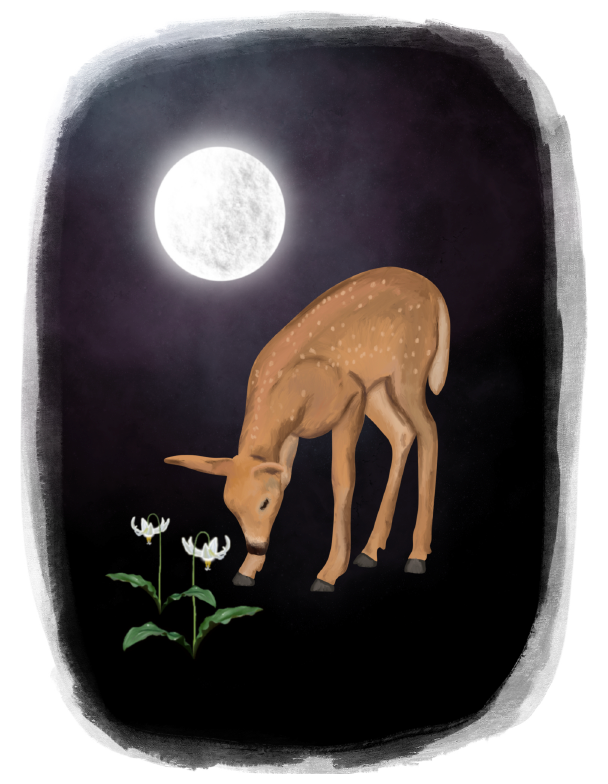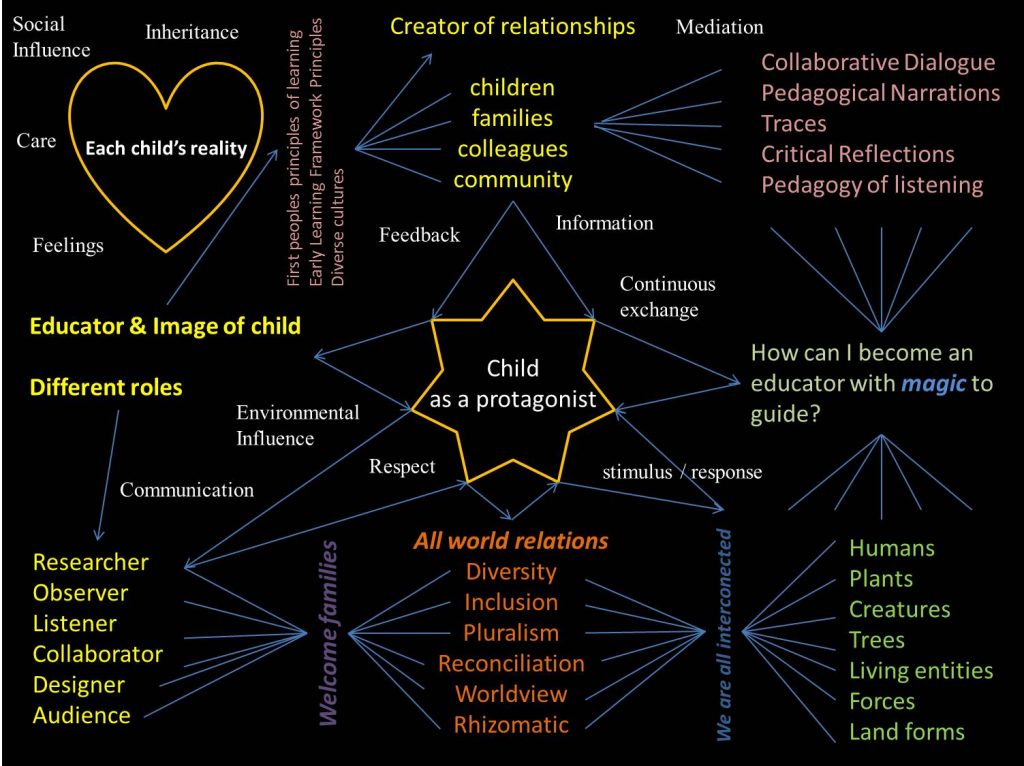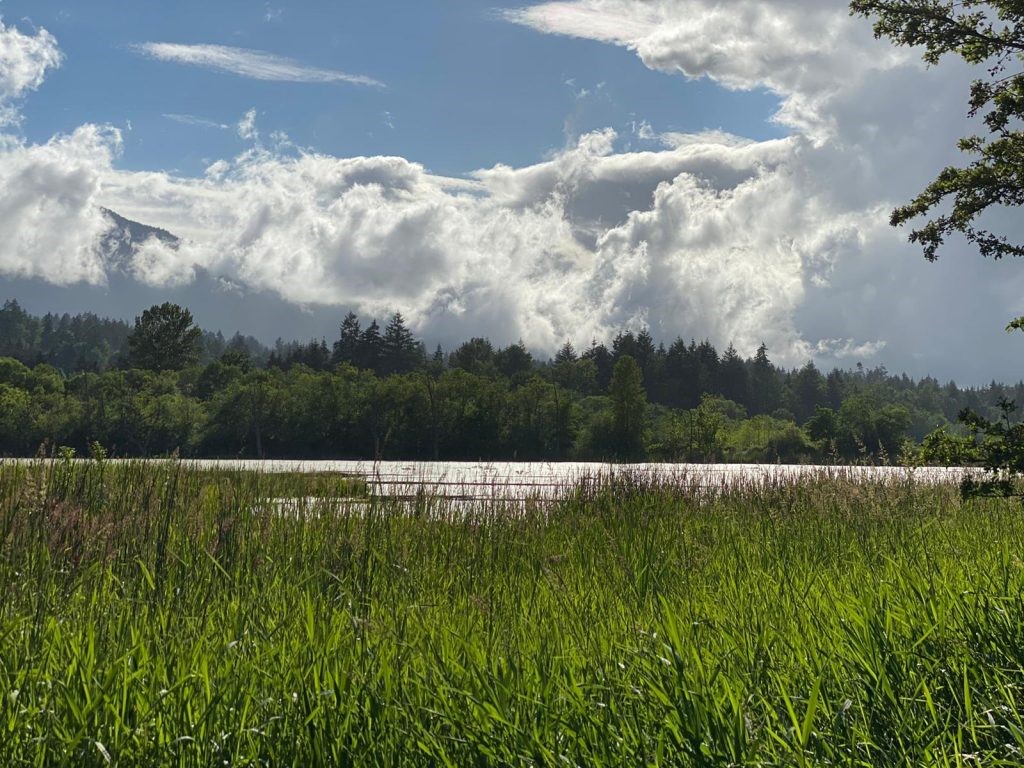By Cali Storch
Category Archives: Outdoor
The Little Fawn and The Lily
Written by Cassia Broomfield
Illustrated by Maillen Garcia
It has been told that the Fawn Lily received its name because the leaves resembled those of a fawn’s ears but, nobody knows how or why the fawn lily resembles a fawn so much. That’s why I am here today. To share the legend of the little fawn and the mysterious lily.

Many centuries ago, before humans roamed the earth, there was a fawn named Artemis. She was a young doe who loved to stray from the rest of the herd and explore the new world around her. Her herd was never afraid, as they were the only animals at the time, they had so very little to worry about. The only thing that scared the herd was the mysterious lily that lived deep in the woods under a giant pine tree. Artemis did not know why they were afraid of a flower because she never listened to her elder’s warnings and cautionary tales about the lily.
One day as Artemis was exploring, she found herself in an unfamiliar place, a place that she had never been before. She looked around to see if she could find her herd, she was alone. By this time Artemis was beginning to get hungry as she had not returned to her home for dinner. She looked up at the sky, the sun had gone to bed, she was greeted by her friend the moon instead.
Artemis continued her path through the woods hoping that she would find a way back home or, at least something to eat. She crept deeper and deeper into the forest until eventually, she reached a clearing. To most, this would not seem strange, but the clearing had the sun shining through the trees; Artemis was sure that she had just seen the night sky only a few minutes ago. Her eyes scanned the mossy rocks and grass and landed upon a giant pine tree. Artemis’ stomach grumbled by just looking at the delicious pine needles. As she was just about to turn around and head home she heard a melancholic voice say “oh Artemis, are you not hungry?” the young fawn whipped her head around to try and find who was speaking to her, but all she found was a tall white lily weeping at the base of the pine. “I am hungry, lost, and very afraid” Artemis whispered back to the lily. “There is nothing to be afraid of here in the forest, come closer, I will offer some of my petals for you to ease your hunger” the lily responded in a gentle tone. Artemis fell under the spell of the lily and soon was munching happily on the now glowing white petals.
After finishing her snack, the light in the clearing turned dark and the moon was visible once again as Artemis lay on the ground and went to sleep. The lily smiled as Artemis fell into a spell-binding sleep. The moon watched helplessly as her dear friend turned into a lily very similar to the one she had eaten the petals from. The moon wept with sorrow as there was nothing she could do to help her friend. The moon’s tears reached the earth and each tear grew into the lily her friend had become. Soon the woodlands had the delicate white flowers blooming all along the forest floor. The moon did not want her friend’s life to be wasted in vain so, the moon gave the new flower the name “Fawn Lily.” Since that day the moon would continue to weep every spring and more fawn lilies would grow covering the forests with the memories of her dear friend Artemis.
Retracing my steps
By Alejandra Gorostiza

The Early Learning Framework (Government of BC, 2019) describes a rhizome as a plant that develops underground and buds in many directions and without a predictable pattern. Inspired by this image, I created this visual map of my learning connections on this wonderful, complex, and unpredictable path to becoming an early childhood educator.
Grateful for so much!
References:
Government of BC. (2019). British Columbia early learning framework. Victoria, BC: Queen’s Printer.
Reimagining Early Childhood Spaces
By Vania Zanetti
In the book Alternative Narratives in Early Childhood: An introduction for Students and Practitioners, Moss (2019) speaks to the idea that the vocabulary we use in early childhood spaces shapes early years practices and experiences. Moss suggests that the dominant language of the early years narrative is “instrumental, calculative and economistic, technical and managerial, dull and lifeless” (p. 81). This makes me thoughtful about theoretical influences that inform the choices that educators make and ultimately shape what is imagined for early childhood spaces.
With the image above I am intrigued to think about the language used to create environments for children. I imagine conversations about safety and regulations that stripped aged trees of lower branches to keep children from scaling higher than they “should”. I wonder, ‘How often, and why, are toys and equipment chosen in early childhood settings because they include words such as safety, quality, durability, and development?
As an alternative to the dominant narrative Moss offers the language used in Reggio Emilia. The language is almost dream-like with a narrative that uses words like exploration, possibility, imagination, and becoming. It makes me wonder about the multiple ways spaces can provoke exploration, project making, and pathways for growth and development. I’m curious about connections to the Early Learning Framework (Government of BC, 2019, p. 77) and welcome the invitation to engage with the critically reflective question, “What opportunities do children have to access materials that can be transformed or investigated?”
I wonder how we can nurture alternative dialogues about children’s spaces. How might these dialogues be informed by the first principle listed in the Early Learning Framework (Government of BC, 2019), “Children are strong, capable in their uniqueness, and full of potential” (p. 15)? What kinds of worlds might become possible?
References:
Government of British Columbia. (2019). British Columbia early learning framework (2nd ed.). Victoria: Ministry of Education, Ministry of Health, Ministry of Children and Family Development, & British Columbia Early Learning Advisory Group. https://www2.gov.bc.ca/gov/content/education-training/early-learning/teach/early-learning-framework
Moss, P. (2019). Reggio Emilia: A story of democracy, experimentation, and potentiality. In Alternative narratives in early childhood: An introduction for students and practitioners (pp. 81). New York, NY: Routledge.
Adventures in the Great Outdoors – Powell River StrongStart
By Kate Boyd and Danielle Cazes
We would like to acknowledge that this was filmed on the traditional territory of the Tla’amin peoples, where we are grateful to work, play and learn.
Kate Boyd has been an Early Childhood Educator for twenty years, working in Young Parent programs, Supported Childcare and currently in StrongStart. She lives In Powell River with her family and enjoys volunteering in her community and exploring the great outdoors.
Danielle Cazes has been in the Early Childhood Education field since 1991. She is currently part of an amazing Strong Start team in Powell River, where she is privileged to participate in play-based, outdoor learning with children and families
“Children’s worlds are small, detailed places – the crack in the sidewalk receives their full attention, as does the earthworm flipping over and over on the pavement after rainfall. They have access to elements of the natural world that many adults don’t acknowledge. When we, like the children, tune ourselves more finely, we find the natural world waiting for us: cycles of light and dark, the feel and scent of the air, the particularities of the sky – these are elements of the natural world and can begin to anchor us in a place.” (Pelo, n.d.)
This quote brings us back to thoughts of our own childhoods and attachment to place. As you watch and listen to the blog post, we invite you to explore the space with the wonder of a child.
Danielle and Kate
Reference
Pelo, A. (n.d.). Rethinking Schools. A pedagogy for ecology. https://rethinkingschools.org/articles/a-pedagogy-for-ecology/
Sensorial Journey to the Great Outdoors
By RoseMary Antony
Growing up in the Middle East I never had many opportunities to explore the outdoors due to harsh desert weather. As I grew up, adapting to indoor life became a part of me and my comfort zone. When I reached B.C, I was blown away by the endless outdoor adventure possibilities. This picture is from my daily walk to Buttertubs Marsh in Nanaimo.

I love listening and using my auditory skills, be it listening to people, music or the sound of crashing waves at the beach, or distant wind chimes on a windy day. One of the first things I did during my early Fall walk at Buttertubs Marsh was to pause, close my eyes and listen. I could hear the frogs croak, ducks splashing and quacking in the water, lizards and small creatures scurrying across tall grass, insects buzzing around my ears, the soft leaves swaying as the gentle breeze blew, all this while feeling the bright sun on my face.
I slowly opened my eyes and looked around to make myself aware of my surroundings again. The Early Learning Framework reminds me that, “Learning is not an individual act but happens in relationship with people, materials, and place” (Government of BC, 2019, p.65). Since spending quality time outside is a relatively new concept for me, I am equally curious and amazed by the novelty of nature and excited to collaborate and engage in reciprocal learning with children.
In A Pedagogy of Ecology, Ann Pelo (n.d.) discusses the significance of developing an ecological identity. She writes, “To foster a love for a place we must engage our bodies and our hearts – as well as our minds – in a specific place” (Pelo, n.d.). As a teacher/researcher, I am inspired by this idea, and wonder what it feels/looks/sounds like to respectfully explore a place with young children. How might children lead us when it comes to exploring the great outdoors? Which paths might become visible? What meaningful experiences could be magnified?
References
Government of British Columbia. (2019). British Columbia early learning framework (2nd ed.). Victoria: Ministry of Education, Ministry of Health, Ministry of Children and Family Development, & British Columbia Early Learning Advisory Group. https://www2.gov.bc.ca/gov/content/education-training/early-learning/teach/early-learning-framework
Pelo, A. (n.d.). Rethinking Schools. A pedagogy for ecology. https://rethinkingschools.org/articles/a-pedagogy-for-ecology/
